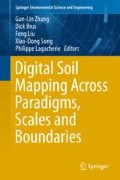Abstract
The GlobalSoilMap project aims to create digital soil property maps in a raster format for six standard depths (0–5; 5–15; 15–30; 30–60; 60–100; 100–200 cm) and, for the first time, with estimates of uncertainty for predicted soil property maps. Data-driven methods and expert knowledge methods have been proposed, both of which present unique challenges. Initially, the majority of the predicted soil property maps will be derived from legacy soil data. The quantification of uncertainty, in particular, presents challenges due to the inherent nature of legacy data coming from different vintages (varying scales, formats, degree of completeness, differences in methods of observations, measurements, and classifications). We discuss the merits of each approach and potential practical and temporary solutions using two case studies from the USA, North America, and Llanos Orientales, Columbia, South America. Both case studies have limited data with insufficient point observations for a meaningful statistical approach for the estimation of prediction interval (PI) uncertainty. For the US case study, the available point measurements are not adequate for PI uncertainty quantification at soil map unit level and furthermore have been purposively collected to support the assignment of estimated mean, upper and lower property values to soil map units. We compared the estimated soil map unit upper and lower limits and 90 % CI from measured pedon for soil pH and found no significant differences between the two. The results suggest that the estimated upper and lower values from soil map units can be used for estimating the 90 % PI uncertainty at least initially until other independent measured point data become available. The available points in Llanos Orientales were collected for soil fertility evaluations and were independent of soil map unit polygons. However, they were surficial samples, clustered, and biased toward cultivated fields. As a result, only the 90 % CI was calculated and was found to be as wide as the range of the mean predicted soil property. These examples highlight few challenges in quantifying the 90 % PI and the need for more measured point data and flexible approaches when dealing with uncertainty quantification.
Access this chapter
Tax calculation will be finalised at checkout
Purchases are for personal use only
References
Ashtekar, J.M., P.R. Owens, R.A. Brown, H.E. Winzeler, M. Dorantes, Z. Libohova, M. Dasilva, A. Castro., 2013. Digital mapping of soil properties and associated uncertainties in the Llanos Orientales, South America. GlobalSoilMap Conference Proceeding, 2013. Orleans, France. Taylor & Francis group, London, UK.
Atehortúa, M., Sanabria, Y., Brito, J., and Rodrigues, S., 2010. LA GEOLOGÍA, GEOMORFOLOGÍA, PEDOLOGÍA Y USO DE LA TIERRA EN LAS MUNICIPALIDADES DE PUERTO LÓPEZ (COLOMBIA) Y UBERLÂNDIA (. Sci-ELO Brasil 22, 329–345.
GlobalSoilMap Science Committee. 2013. Specifications: Tiered GlobalSoilMap.net Products, Release 2.3.
Goosen, D., 1971. Physiography and soils of the Llanos Orientales, Colombia.
Jarvis, A., H.I. Reuter, A. Nelson, E. Guevara, 2008, Hole-filled SRTM for the globe Version 4, available from the CGIAR-CSI SRTM 90m Database (http://srtm.csi.cgiar.org).
Jasiewicz, J. and T.F Stepinski (2013) Geomorphons -a pattern recognition approach to classification and mapping of lanforms. Geomorphology 182, pp. 147-156.
Lagacherie, P., and A.B. McBratney (2007) Spatial Soil Information Systems and Spatial Soil Inference Systems: Perspectives for Digital Soil Mapping, 3-22. In Digital Soil Mapping: an Introductory perspective. http://www.sciencedirect.com/science/
Lilburne, L., Hewitt, A.E., & Ferriss, S. 2009. Progress with the design of a soil uncertainty database, and associated tools for simulating spatial realisations of soil properties. M. Caetano & M. Painho (eds), 7th International Symposi-um on Spatial Accuracy Assessment in Natural Resources and Environmental Science. Lisbon, Portugal, pp. 510–519.
Libohova, Z., S. Wills, and N.P. Odgers, 2013. Legacy Data Quality and Uncertainty Estimation for United States GlobalSoilMap Products. GlobalSoilMap Conference Proceeding, Orleans, France. Edited by Dominique Arrouays, Neil McKenzie, Jon Hempel, Ann C. Richer de Forges, and Alex McBratney. CRC Press 2014, pages 63–68. Print ISBN: 978-1-138-00119-0, eBook ISBN: 978-1-315-77558-6, DOI: 10.1201/b16500-18.
Malone, B.P., McBratney, A.B., Minasny, B., 2011a. Empirical estimates of uncertainty for mapping continuous depth functions of soil attributes. Geoderma 160(3-4), 614-626.
Malone, B.P., de Gruijter, J.J., McBratney, A.B. Minasny, B., & Brus, D.J. 2011b. Using additional criteria for measuring the quality of predictions and their uncertainties in a digital soil mapping framework. Soil Science Society of America Journal 75:1032–1043.
Mallavan, B.B., Minasny, B., and McBratney, A.B., 2010. Homosoil, a Methodology for Quantitative Extrapolation of Soil Information Across the Globe. In J.L. Boettinger et al. (eds.), Digital Soil Mapping in Soil Science 2.
Minasny, B. & McBratney, A.B. 2010. Methodologies for global soil mapping. In J.L. Boettinger, D.W. Howell, A.C. Moore, A.E. Hartemink & S. Kienast-Brown (eds), Digital soil mapping: bridging research, environmental application, and operation: 429–436. Springer Science+Business Media.
Odgers, N.P., Libohova, Z., Thompson, J.A., 2012. Equal-area spline functions applied to a legacy soil database to create weighted-means maps of soil organic carbon at a continental scale. Geoderma 189–190, 153–163. doi: 10.1016/j.geoderma.2012.05.026.
Ott, R.L., Longnecker, M., 2001. An introduction to statistical methods and data analysis (5th edtition).
USDA-NRCS. 2013. National Soil Survey Handbook. Available at http://soils.usda.gov/technical/handbook/ (accessed 27 May 2013). United States Department of Agriculture-Natural Resources Conservation Service.
Zhu, A.X., Hudson, B., Burt, J., Lubich, K., Simonson, D., 2001. Soil Mapping Using GIS, Expert Knowledge, and Fuzzy logic. Soil Science Society of America Journal, 65(5), 1463-1472.
Author information
Authors and Affiliations
Corresponding author
Editor information
Editors and Affiliations
Rights and permissions
Copyright information
© 2016 Springer Science+Business Media Singapore
About this chapter
Cite this chapter
Libohova, Z., Odgers, N.P., Ashtekar, J., Owens, P.R., Thompson, J.A., Hempel, J. (2016). Some Challenges on Quantifying Soil Property Predictions Uncertainty for the GlobalSoilMap Using Legacy Data. In: Zhang, GL., Brus, D., Liu, F., Song, XD., Lagacherie, P. (eds) Digital Soil Mapping Across Paradigms, Scales and Boundaries. Springer Environmental Science and Engineering. Springer, Singapore. https://doi.org/10.1007/978-981-10-0415-5_11
Download citation
DOI: https://doi.org/10.1007/978-981-10-0415-5_11
Published:
Publisher Name: Springer, Singapore
Print ISBN: 978-981-10-0414-8
Online ISBN: 978-981-10-0415-5
eBook Packages: Earth and Environmental ScienceEarth and Environmental Science (R0)

